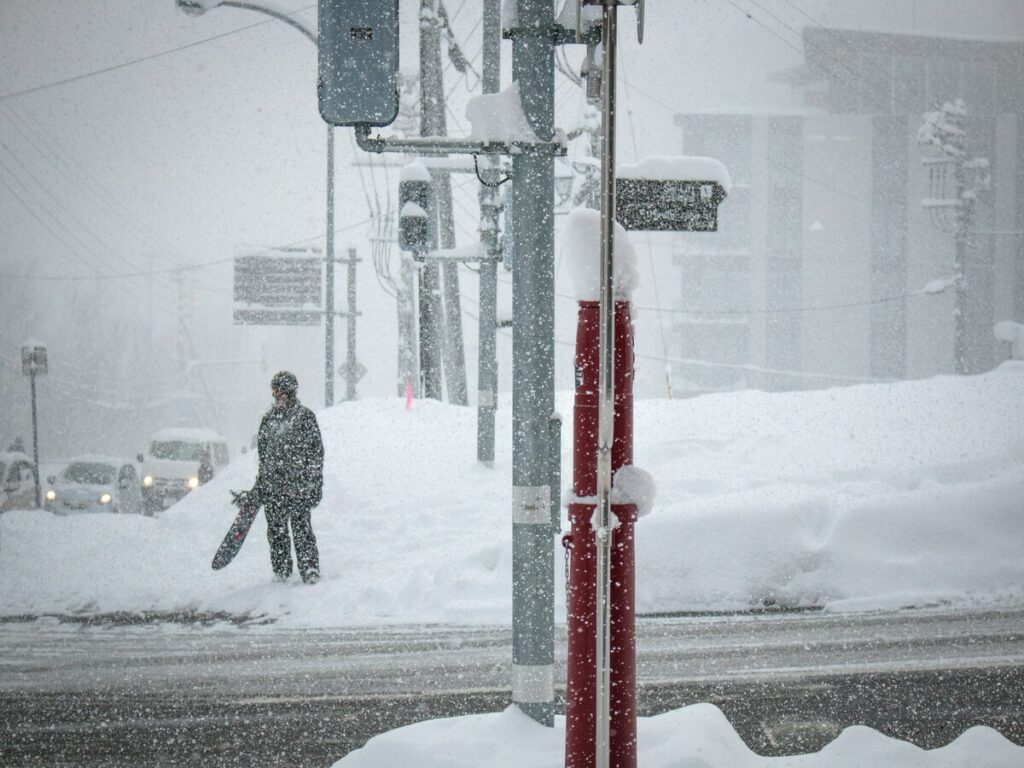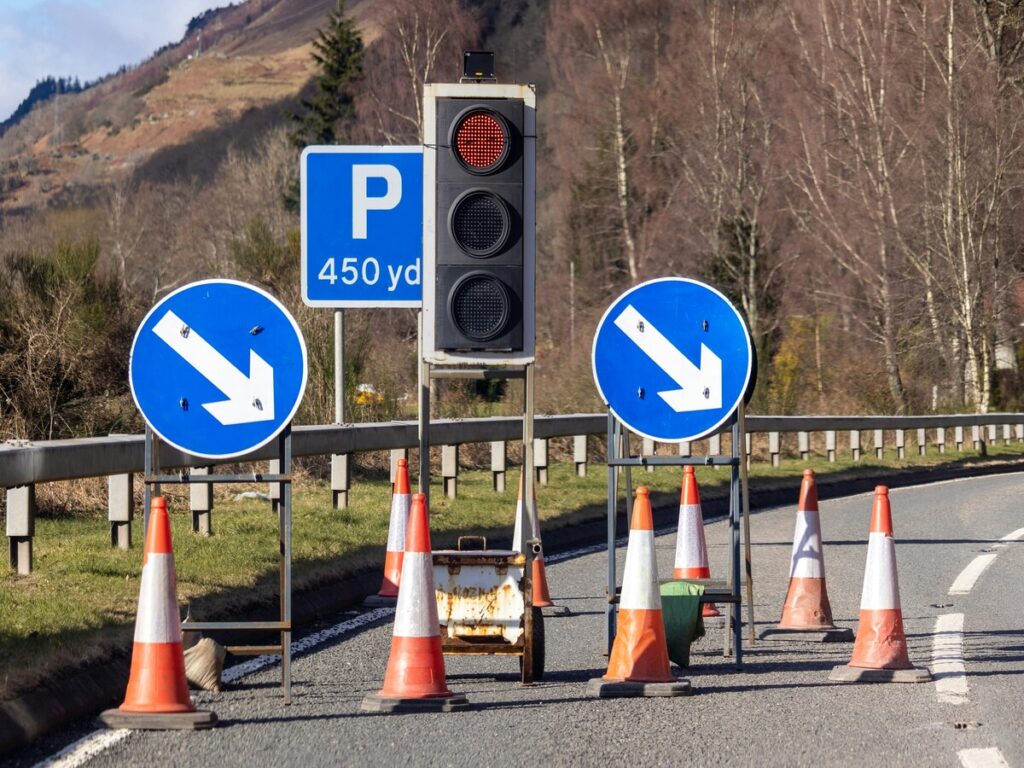
IL forte tempesta invernale all'inizio 2025 ha già colpito gli Stati Uniti, portando sfide uniche alla sicurezza stradale. Forti nevicate, strade ghiacciate, e la visibilità imprevedibile richiedono soluzioni innovative. I coni di sicurezza svolgono un ruolo vitale nel mantenere i conducenti al sicuro. Questi coni stradali guidare il traffico, segnalare i pericoli, e prevenire incidenti in condizioni pericolose. Per esempio, aiutano gli spazzaneve a segnare i loro percorsi e ad avvisare i conducenti delle aree scivolose. Adattarsi alle moderne tendenze costruttive, come l'utilizzo di coni riflettenti o dotati di LED, garantisce visibilità anche in condizioni di scarsa illuminazione. Dando priorità alla sicurezza, puoi percorrere le strade invernali con maggiore sicurezza.
Importanza dei coni di sicurezza in condizioni climatiche invernali rigide

Migliorare la sicurezza e la visibilità
Ruolo dei coni riflettenti in condizioni di scarsa illuminazione e neve
Il clima invernale spesso porta scarsa visibilità a causa delle tempeste di neve e delle ore diurne più brevi. I coni di sicurezza riflettenti assicurano che i conducenti possano vedere i pericoli anche in queste condizioni difficili. Il loro nastro retroriflettente cattura i fari, rendendoli visibili a distanza. Alcuni coni stradali, come quelli di Segni OPT, anche includere Luci a LED per una migliore visibilità di notte o durante forti nevicate. Queste funzionalità ti aiutano a rimanere aggiornato sulle condizioni stradali ed evitare potenziali pericoli.
Segnalazione di pericoli come zone ghiacciate e ostacoli coperti di neve
I coni di sicurezza svolgono un ruolo fondamentale nella segnalazione delle aree pericolose. Avvisano i conducenti della presenza di zone ghiacciate, ostacoli coperti di neve, e altri pericoli che altrimenti potrebbero passare inosservati. Per esempio, gli spazzaneve utilizzano coni di sicurezza stradale per contrassegnare i loro percorsi, garantendo che sia gli operatori che i conducenti nelle vicinanze rimangano al sicuro. Identificando chiaramente questi rischi, i coni di sicurezza stradale riducono la probabilità di incidenti.
Guidare il flusso del traffico in aree pericolose
I coni stradali aiutano a reindirizzare i veicoli attorno ai pericoli e a creare deviazioni sicure. Questa guida è particolarmente importante durante forti tempeste invernali quando le condizioni stradali possono cambiare rapidamente. I coni segnano anche i bordi delle strade, impedire ai veicoli di deviare nei fossati o in altre aree non sicure. Il loro posizionamento strategico garantisce un flusso di traffico più regolare e migliora la sicurezza generale.
Sfide poste dal clima invernale
Neve e ghiaccio riducono la stabilità e la visibilità del cono
La neve e il ghiaccio possono rendere difficile la stabilità dei coni. Forti venti e forti nevicate potrebbero farli ribaltare o seppellire. Basi ponderate o coni specializzati progettati per condizioni meteorologiche estreme possono aiutare a risolvere questo problema, assicurandosi che rimangano in posizione verticale e visibili.
Scarsa visibilità causata dalla nebbia, tempeste di neve, e ore diurne più brevi
Nebbia e tempeste di neve riducono notevolmente la visibilità, rendendo più difficile per i conducenti vedere i coni. Le ore diurne più brevi durante l’inverno aggravano ulteriormente questo problema. I materiali riflettenti e i coni dotati di LED sono essenziali per mantenere la visibilità in queste condizioni.
Aumento dei rischi di incidenti senza un’adeguata gestione del traffico
Senza una corretta gestione del traffico, il clima invernale aumenta il rischio di incidenti. Strade scivolose, pericoli nascosti, e la scarsa visibilità creano condizioni di guida pericolose. I coni di sicurezza mitigano questi rischi guidando il traffico, marcatura dei pericoli, e promuovere comportamenti di guida più sicuri. La loro presenza può fare la differenza tra un viaggio sicuro e un incidente prevenibile.
Strategie chiave del cono stradale per la tempesta invernale
Coni di spaziatura per tenere conto dei cumuli di neve e delle zone ghiacciate
La corretta spaziatura dei coni stradali è fondamentale per garantire la sicurezza durante l'inverno. Dovresti posizionare i coni di sicurezza sufficientemente distanti per tenere conto dei cumuli di neve che potrebbero oscurarne la visibilità. Questa spaziatura aiuta anche i conducenti a spostarsi senza confusione nelle zone ghiacciate. I coni possono guidare i veicoli in sicurezza attraverso aree pericolose segnalando deviazioni o reindirizzando il traffico. Indicatori e delineatori riflettenti migliorare ulteriormente la visibilità, aiutare i conducenti a rallentare o a cambiare corsia in sicurezza.
Evitare il posizionamento in aree soggette a interferenze spazzaneve
Quando si posizionano i coni, evitare le aree in cui spazzaneve operare frequentemente. Gli spazzaneve possono spostare o danneggiare i coni, riducendone l’efficacia. Usa i coni stradali per segnare la posizione degli spazzaneve, proteggere gli operatori dal traffico in arrivo. Inoltre, i coni possono segnare i bordi e le banchine della strada, impedendo ai veicoli di deviare da strade scivolose.
Utilizzo di coni ponderati o specializzati
Vantaggi delle basi ponderate per la stabilità in caso di vento forte e neve
Le basi ponderate migliorano la stabilità del cono durante le rigide condizioni invernali. Forti venti e forti nevicate possono facilmente ribaltare i coni standard. Utilizzando coni con basi appesantite, ti assicuri che rimangano in posizione verticale e visibili. Questa stabilità è essenziale per mantenere la sicurezza sulle strade ghiacciate.
Coni specializzati progettati per durabilità in condizioni climatiche estreme
Coni specializzati realizzati con materiali durevoli come la plastica rinforzata, PVC, o la gomma resiste alle condizioni atmosferiche estreme. I coni resistenti resistono alla rottura o alla frantumazione a temperature gelide. Per esempio, il Cono-Ambiente, costruito da Polietilene a bassa densità (LDPE), rimane flessibile e durevole anche in condizioni di freddo intenso. Questi coni forniscono prestazioni di lunga durata, garantendo sicurezza durante tutta la stagione invernale.
Coni riflettenti e dotati di LED
Importanza dei materiali riflettenti per l'uso notturno e in condizioni di scarsa illuminazione
I materiali riflettenti sono essenziali per mantenere la visibilità in condizioni di scarsa illuminazione. Il nastro retroriflettente sui coni aumenta le distanze di rilevamento, rendendoli visibili agli automobilisti anche durante le tempeste di neve. Prodotti come i coni Traffix Devices utilizzano questo nastro per migliorare la sicurezza garantendo che i conducenti possano vedere i pericoli a distanza.
Utilizzo di coni dotati di LED per migliorare la visibilità durante le tempeste di neve
I coni dotati di LED offrono un'illuminazione aggiuntiva, rendendoli altamente efficaci durante le tempeste di neve. Questi coni si distinguono in caso di maltempo, garantire che gli autisti possano navigare in sicurezza. Per esempio, I coni di Cortina Corporation includono luci LED opzionali che migliorano la visibilità in ambienti scarsamente illuminati. Utilizzando questi coni, migliori la sicurezza stradale e riduci i rischi di incidenti.
Mancia: Ispezionare regolarmente i coni per eventuali danni o usura per garantire che rimangano efficaci durante tutto l'inverno.
Consigli per la manutenzione dei coni di sicurezza
Eliminare regolarmente neve e ghiaccio dai coni
Neve e ghiaccio possono accumularsi rapidamente sui coni di sicurezza durante i temporali invernali. Questo accumulo riduce la loro visibilità ed efficacia. Dovresti ispezionare frequentemente i coni, soprattutto dopo forti nevicate o pioggia gelata. Utilizzare una spazzola o un raschietto per rimuovere neve e ghiaccio dalla superficie. Concentrarsi sull'eliminazione delle aree riflettenti per mantenerne la visibilità. Se i coni vengono sepolti nei cumuli di neve, riposizionarli per garantire che rimangano visibili ai conducenti. La manutenzione regolare mantiene i coni funzionali e migliora la sicurezza stradale.
Controllo della riflettività e sostituzione dei coni danneggiati
Materiali riflettenti sui coni si consumano nel tempo, soprattutto in condizioni invernali rigide. Dovresti controllare regolarmente la riflettività dei coni. Puntali su una torcia o sui fari di un'auto per testarne la visibilità. Se il nastro riflettente appare opaco o danneggiato, sostituirlo immediatamente. Coni danneggiati, come quelli con crepe o parti mancanti, andrebbe anche sostituito. L'uso dei coni stradali in buone condizioni garantisce che rimangano efficaci nel guidare il traffico e segnalare i pericoli. Questa pratica migliora la sicurezza generale su strade ghiacciate e innevate.
Mancia: Conserva coni e nastro riflettente di riserva nel tuo veicolo o nell'area di stoccaggio. Questa preparazione consente di sostituire rapidamente i coni danneggiati durante le emergenze.
Adattamento a scenari meteorologici estremi
Strategie per forti nevicate e bufere di neve

Distribuzione di coni con caratteristiche di visibilità e stabilità più elevate
Forti nevicate e bufere di neve creare condizioni di guida pericolose. Puoi migliorare la sicurezza utilizzando coni stradali con maggiore visibilità e stabilità. Indicatori e delineatori riflettenti sui coni avvisano i conducenti di strade scivolose, incoraggiandoli a rallentare o a cambiare corsia in sicurezza. Gli spazzaneve spesso fanno affidamento sui coni per contrassegnare la loro posizione, proteggere gli operatori dal traffico in arrivo. Questi coni stradali aiutano anche a reindirizzare i veicoli attorno ai pericoli, garantire un flusso di traffico più regolare in condizioni meteorologiche estreme. Basi appesantite o coni specializzati progettati per la resistenza invernale migliorano ulteriormente la loro efficacia in queste condizioni.
Adeguamento del posizionamento per tenere conto dell'accumulo di neve
L'accumulo di neve può oscurare i coni, rendendoli meno visibili agli automobilisti. Per affrontare questo problema, dovresti regolare frequentemente il posizionamento del cono durante forti nevicate. Posizionare i coni stradali nelle aree in cui è meno probabile che si formino cumuli di neve, come tratti sopraelevati della strada. Ispezionare e riposizionare regolarmente i coni stradali per garantire che rimangano visibili. Questo approccio proattivo riduce al minimo i rischi e mantiene il traffico in movimento in sicurezza attraverso aree pericolose.
Schieramento del cono di emergenza
Strategie di risposta rapida per improvvise tempeste di neve o ghiaccio
Improvvise tempeste di neve o ghiaccio richiedono un’azione rapida. Puoi distribuire rapidamente i coni stradali per proteggere le scene degli incidenti o guidare i veicoli lontano da aree pericolose. I coni per carichi pesanti sono particolarmente efficaci nelle emergenze grazie alla loro durata e visibilità. La loro capacità di resistere a condizioni difficili li rende uno strumento affidabile per la gestione del traffico durante i disastri naturali. Agendo rapidamente, puoi ridurre la confusione e aumentare la sicurezza per tutti gli utenti della strada.
Utilizzo di coni portatili per una distribuzione rapida
I coni portatili sono una strategia di sopravvivenza essenziale per gli scenari di emergenza. Il loro design leggero ti consente di trasportarli e distribuirli rapidamente. Questi coni sono ideali per creare deviazioni temporanee o segnalare pericoli durante eventi meteorologici imprevisti. La loro portabilità garantisce la possibilità di rispondere in modo efficace alle mutevoli condizioni, mantenendo la sicurezza anche in situazioni di alta pressione.
Collaborare con Autorità locali
Coordinamento con le squadre spazzaneve per garantire un efficace posizionamento dei coni
La collaborazione con le squadre spazzaneve è vitale per ottimizzare il posizionamento dei coni. Una comunicazione efficace aiuta a coordinare il controllo del traffico durante le operazioni invernali. Gli spazzaneve creano spesso zone di lavoro mobili che richiedono un'attenta pianificazione. Comprendendone i percorsi e le dinamiche, puoi posizionare i coni in modo strategico per proteggere sia gli operatori che i conducenti. Questo lavoro di squadra migliora la sicurezza e garantisce una gestione stradale più fluida in condizioni meteorologiche estreme.
Condivisione di risorse e strategie con i team di gestione del traffico locale
Lavorare con i team locali di gestione del traffico rafforza la tua capacità di gestire i cambiamenti climatici. Condivisione delle risorse, come coni e materiali riflettenti, garantisce che tutti siano preparati per condizioni difficili. Le sessioni di pianificazione congiunta possono aiutare a sviluppare progetti resilienti che affrontano le sfide uniche del clima invernale. Questa collaborazione promuove un approccio unificato alla sicurezza stradale, a beneficio dell’intera comunità.
Mancia: Mantenere sempre una comunicazione aperta con le autorità locali e gli operatori degli spazzaneve per adattarsi rapidamente alle mutevoli condizioni meteorologiche.
I coni stradali saranno la tua difesa in prima linea contro le sfide dell'inverno. Migliorano la sicurezza guidando il traffico, marcatura dei pericoli, e riducendo i rischi di incidenti. Strategie chiave come il corretto posizionamento, utilizzando coni appesantiti o riflettenti, e una manutenzione regolare ne garantiscono l’efficacia. Adattarsi all’evoluzione delle tendenze costruttive, come l'implementazione di coni dotati di LED, mantiene le strade più sicure durante le tempeste di neve. Puoi anche collaborare con le autorità locali per ottimizzare l'uso del cono. Preparandosi in anticipo, proteggi te stesso e gli altri dai pericoli dell'inverno garantendo al tempo stesso un flusso di traffico più regolare.
Nota: Rimani informato sugli aggiornamenti meteorologici invernali con strumenti come Aggiornamento meteo FOX per pianificare in modo efficace.



















